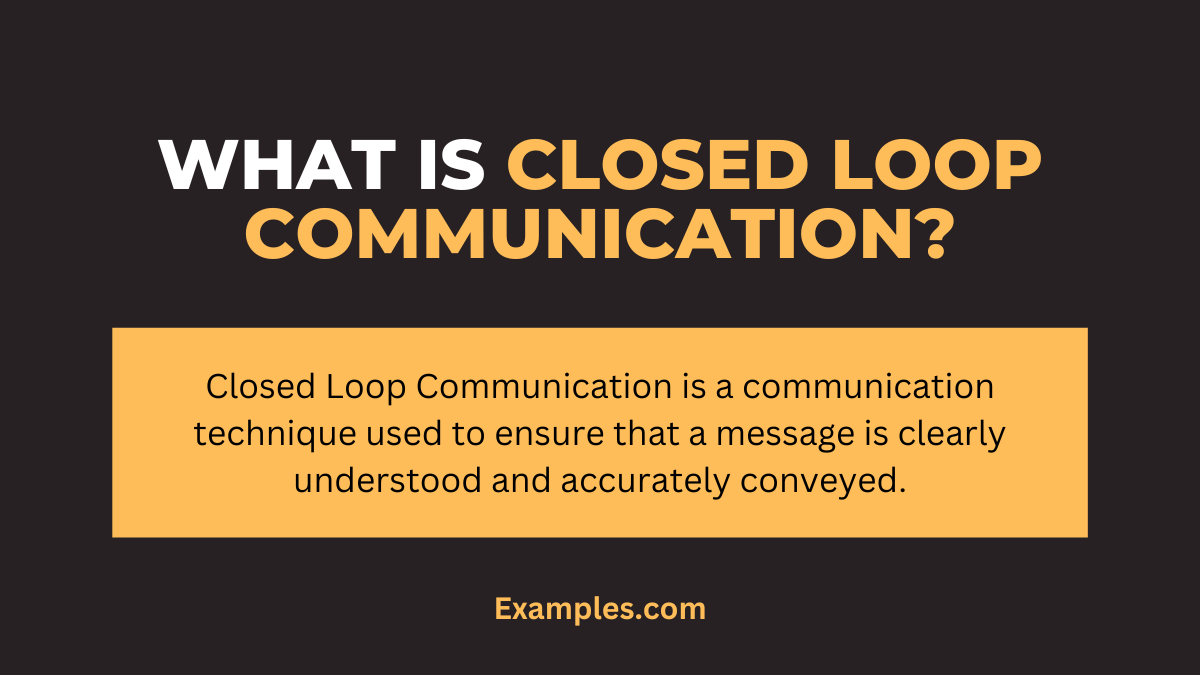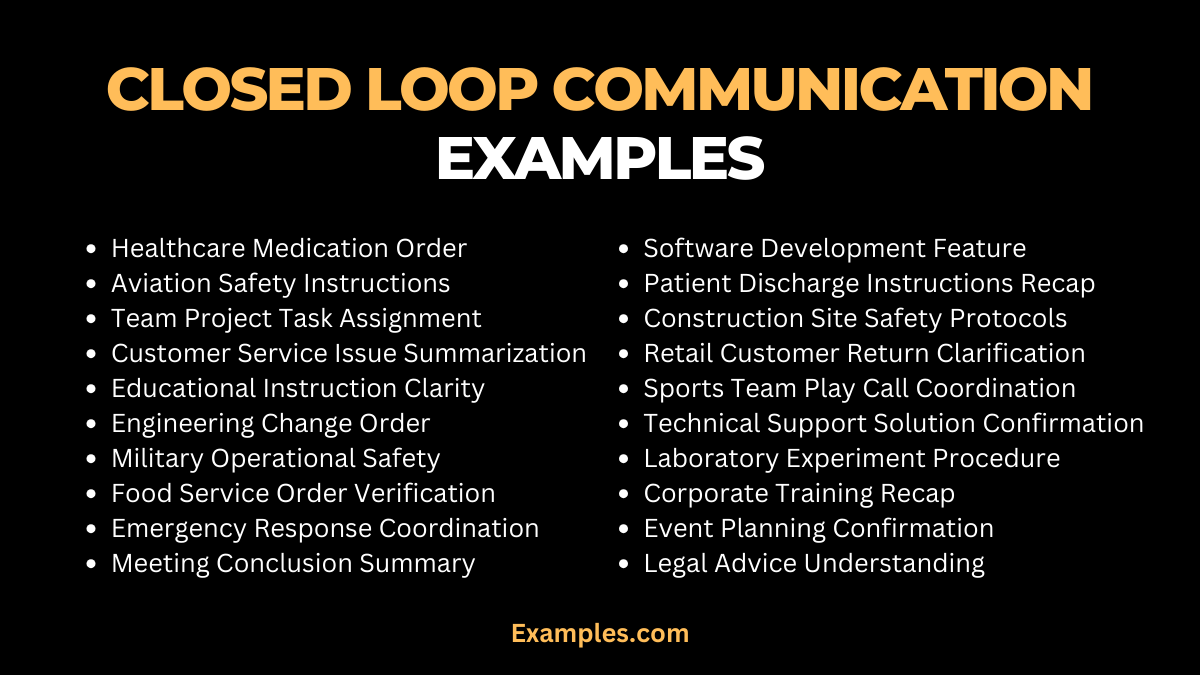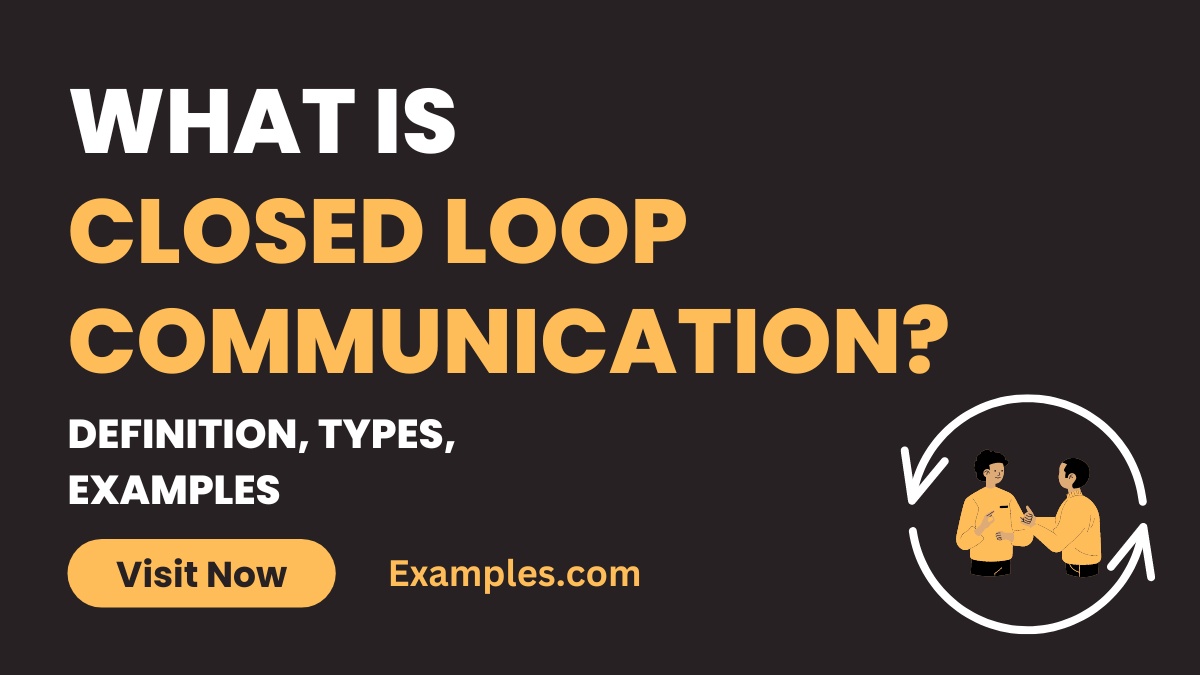What is Closed Loop Communication?
Closed Loop Communication is a structured method of communication designed to ensure clarity and prevent misunderstandings, especially in high-stakes environments. This guide will delve into the concept of Closed Loop Communication, providing real-world communication examples, exploring its origins, and offering practical tips for its implementation. The guide aims to illustrate the importance of this communication method in various settings, such as healthcare and aviation, where accurate information exchange is critical. Understanding and applying Closed Loop Communication can significantly reduce errors and enhance the effectiveness of team interactions.
What is Closed Loop Communication? – Definition and Meaning

Closed Loop Communication is a communication technique used to ensure that a message is clearly understood and accurately conveyed. It involves a process where the sender delivers a message, the receiver repeats or paraphrases it back to confirm understanding, and the sender verifies the accuracy of the receiver’s response. This method minimizes misunderstandings and errors, particularly in high-stakes environments like healthcare, aviation, and emergency services, where clear and precise communication is crucial.
What is Closed Loop Communication? – Examples Bundle
Download Now in PDF20 Closed Loop Communication Examples

Closed Loop Communication is a critical method in ensuring clear and effective communication, particularly in high-stakes environments like healthcare and aviation. This technique involves a sender initiating a message, the receiver repeating or paraphrasing it, and the sender confirming its accuracy. This process ensures that the information is correctly understood and acted upon, minimizing errors due to miscommunication.
- Healthcare Instruction: A doctor orders a medication, a nurse repeats the dosage and medication back, and the doctor confirms. This ensures correct medication administration.
- Aviation Safety: A pilot receives air traffic instructions, repeats them back to the controller, who then confirms, ensuring safe navigation.
- Team Project Update: A manager assigns tasks, each team member repeats their specific tasks, and the manager confirms, ensuring clarity on responsibilities.
- Customer Service Request: A customer service representative summarizes a customer’s issue, the customer confirms or corrects the summary, enhancing problem resolution efficiency.
- Educational Instruction: A teacher gives a complex instruction, a student paraphrases it, and the teacher confirms, ensuring understanding.
- Engineering Change Order: An engineer communicates a technical change, the project manager repeats it for clarity, and the engineer confirms, ensuring accurate implementation.
- Military Operation: A commander issues an order, the subordinate repeats it back, and the commander confirms, ensuring operational safety.
- Food Service Order: A waiter repeats a customer’s order, the customer confirms, and the waiter acknowledges, ensuring accurate order fulfillment.
- Emergency Response Coordination: An emergency coordinator issues instructions, responders repeat them, and the coordinator confirms, ensuring effective disaster response.
- Meeting Conclusion Summary: At the end of a meeting, the facilitator summarizes key decisions, attendees confirm understanding, ensuring alignment on action items.
- Software Development Update: A software team leader describes a new feature, a developer paraphrases the requirements, and the leader confirms, ensuring accurate development.
- Patient Discharge Instructions: A nurse explains discharge instructions to a patient, who then summarizes the key points, and the nurse confirms, ensuring the patient understands their post-care protocol.
- Construction Site Safety: A site manager communicates safety protocols, a worker repeats them, and the manager confirms, ensuring a safe working environment.
- Retail Customer Clarification: A customer explains a return reason, the salesperson repeats the reason, and the customer confirms, ensuring a smooth return process.
- Sports Team Play Call: A coach outlines a play, players repeat it, and the coach confirms, ensuring team coordination.
- Technical Support Solution: A tech support specialist provides a solution, the caller repeats the steps, and the specialist confirms, ensuring correct problem-solving.
- Laboratory Experiment Procedure: A scientist explains an experiment protocol, a lab assistant repeats the steps, and the scientist confirms, ensuring accuracy in the experiment.
- Corporate Training Recap: At the end of a training session, the trainer summarizes key points, trainees repeat the main takeaways, and the trainer confirms, ensuring effective learning.
- Event Planning Confirmation: An event planner details arrangements, the client repeats the details, and the planner confirms, ensuring event success.
- Legal Advice Understanding: A lawyer explains legal options, the client paraphrases their understanding, and the lawyer confirms, ensuring clear legal advice comprehension.
What is Closed Loop Communication in CPR?
Closed Loop Communication in Cardiopulmonary Resuscitation (CPR) is vital for ensuring that life-saving instructions and actions are clearly understood and executed accurately. During a CPR scenario, where every second counts, Closed Loop Communication helps prevent any miscommunication that could delay or complicate the resuscitation process. For example, if a responder says, “Administer 30 chest compressions,” the assistant would repeat, “30 chest compressions,” before proceeding. This ensures clarity and effectiveness in emergency medical situations.
What are the Types of Closed Loop Communication?
Closed Loop Communication can be categorized into several types, each suited to different contexts:
- Verbal Confirmation: This type involves the receiver verbally repeating or paraphrasing the message back to the sender. This step is crucial in ensuring that the message conveyed is the message received, especially in high-stakes settings like healthcare or aviation, where precise understanding is paramount.
- Non-Verbal Acknowledgment: In situations where verbal communication is not feasible, such as noisy environments or when using personal protective equipment, non-verbal cues like nodding, hand gestures, or written notes are used to acknowledge receipt and understanding of the message.
- Written Confirmation: Commonly used in settings where maintaining records is essential, such as in medical charting or legal documentation. Written confirmation provides a tangible record of communication, ensuring clarity and serving as a reference point for future actions or decisions.
- Technological Aids: This includes the use of electronic devices or software to enhance communication. Examples include messaging apps, electronic health records, and specialized communication tools in aviation. These aids help in delivering and confirming messages accurately, especially over long distances or in complex systems.
- Feedback-Based Communication: This approach is interactive, where the receiver of the message provides feedback or asks questions for clarification. This ensures mutual understanding and can be particularly useful in educational settings or team collaborations, where ongoing dialogue and clarification are necessary.
Tips for Effective Closed Loop Communication
Here are the Tips for Effective Closed Loop Communication:
- Clarity in Initial Messaging: Start every conversation with a clear, direct message, avoiding any ambiguities that might lead to misunderstandings.
- Active Listening: Ensure that the receiver of the message is not only hearing but also understanding the content, reinforcing the importance of attentive listening.
- Encourage Repetition: Asking the receiver to repeat or paraphrase the message helps in verifying that the message is understood correctly.
- Confirm Accuracy: The sender should take responsibility to confirm that the receiver’s understanding matches the intended message.
- Foster Openness: Create a communication environment where asking questions and seeking clarifications is encouraged and valued.
- Regular Training: Especially important in healthcare settings, routine training in Closed Loop Communication can help in ingraining these practices.
- Adapt to Context: Modify the approach of Closed Loop Communication depending on the specific situation, such as patient-nurse interactions.
- Technology Integration: Where applicable, use technology to support and enhance the Closed Loop Communication process.
- Feedback Mechanisms: Integrate feedback loops into the communication process to allow for ongoing improvement and adaptation.
- Understand Different Communication Styles: Recognize and adapt to diverse communication styles, especially in varied settings like nursing, to ensure effective communication.
Closed Loop Communication is a critical component in various sectors, particularly in healthcare. Understanding and implementing Closed Loop Communication in Medical settings, for instance, is essential for patient safety. The Importance of Closed Loop Communication cannot be overstated, especially in comparison with Open Loop vs Closed Loop Communication, where the latter provides a more robust framework for clear and effective information exchange.
Statistics Highlighting the Closed Loop Communication
Closed Loop Communication is a communication method that is especially important in high-stakes environments like healthcare. It involves a series of steps to ensure that a message is correctly conveyed and understood. The process starts with the sender initiating a message, followed by the receiver acknowledging, clarifying, and confirming the message. Feedback is then provided, actions are verified, and important communications are documented. This method is crucial for reducing errors and enhancing understanding in complex situations.
In healthcare, Closed Loop Communication is vital for patient safety and efficient care. It ensures clear and precise communication between medical professionals, which is crucial for delivering effective treatment and avoiding medical errors. The Agency for Healthcare Research and Quality (AHRQ) offers resources and tools to facilitate Closed Loop Communication in medical settings, emphasizing its significance in ensuring quality patient care??.
For more detailed information on Closed Loop Communication, especially in healthcare settings, you can refer to the Agency for Healthcare Research and Quality’s resources on this topic??.



